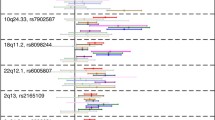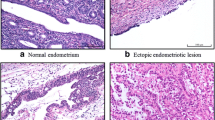Abstract
Patterns of allele loss (loss of heterozygosity (LOH)) were studied to identify the genetic backgrounds underlying the two putative carcinogenic pathways of ovarian clear-cell adenocarcinoma: carcinomas thought to arise in endometriosis (endometriosis-associated carcinomas, 20 cases) and carcinomas thought to be derived from clear-cell adenofibroma ((CCAF)-associated carcinomas, 14 cases). Each tumor was assessed for LOH at 24 polymorphic loci located on 12 chromosomal arms: 1p, 3p, 5q, 8p, 9p, 10q, 11q, 13q, 17p, 17q, 19p, and 22q. For all informative loci, the frequency of LOH was not statistically different between the two carcinoma groups: 38% (66/172 loci) in the endometriosis-associated carcinomas and 35% (40/113 loci) in the CCAF-associated carcinomas. In the endometriosis-associated carcinomas, LOH was detected at high frequencies (>50%) at 3p, 5q, and 11q and at low frequencies (<20%) at 8p, 13q, and 17p. In the CCAF-associated carcinomas, LOH was detected at high frequencies at 1p, 10q, and 13q and at low frequencies at 3p, 9p, 11q, and 17q. The frequencies of LOH at chromosomes 3p, 5q, and 11q were significantly higher in the endometriosis-associated carcinomas than in the CCAF-associated carcinomas (P = 0.026, 0.007, and 0.011, respectively). Immunohistochemical analysis demonstrated a close association between the allelic status of the 3p25–26 locus and levels of von Hippel–Lindau (VHL) protein expression (P = 0.0026). These data further support the presence of two distinct carcinogenic pathways to ovarian clear-cell adenocarcinoma; the allelic status of the 3p, 5q, and 11q loci may provide a means to identify the precursor lesions of these carcinomas.



Similar content being viewed by others
References
Seidman JD, Russell P, Kurman RJ (2001) Surface epithelial tumors of the ovary. In: Kurman RJ (ed) Blaustein's pathology of the female genital tract, 5th edn. Springer, New York, pp 791–904
Sugiyama T, Kamura T, Kigawa J et al (2000) Clinical characteristics of clear cell carcinoma of the ovary: a distinct histologic type with poor prognosis and resistance to platinum-based chemotherapy. Cancer 88:2584–2589
Ikeda K, Sakai K, Yamamoto R et al (2003) Multivariate analysis for prognostic significance of histologic subtype, GST-pi, MDR-1, and p53 in stages II–IV ovarian cancer. Int J Gynecol Cancer 13:776–784
Tavassoli FA, Devilee P (eds) (2003) World Health Organization classification of tumours. Pathology and genetics of tumours of the breast and female genital organs. IARC Press, Lyon
Kaku T, Ogawa S, Kawano Y et al (2003) Histological classification of ovarian cancer. Med Electron Microsc 36:9–17
Gynecologic Cancer Comittee, Japan Society of Obstetrics and Gynecology (2008) Annual report of gynecological cancer patients in Japan 2006. Acta Obstet Gynaecol Jpn 60:1001–1085 (in Japanese)
Sampson JA (1925) Endometrial carcinoma of the ovary arising in endometrial tissue in that organ. Arch Surg 10:1–72
Vercellini P, Parazzini F, Bolis G et al (1993) Endometriosis and ovarian cancer. Am J Obstet Gynecol 169:181–182
Fukunaga M, Nomura K, Ishikawa E et al (1997) Ovarian atypical endometriosis: its close association with malignant epithelial tumours. Histopathology 30:249–255
Ogawa S, Kaku T, Amada S et al (2000) Ovarian endometriosis associated with ovarian carcinoma: a clinicopathological and immunohistochemical study. Gynecol Oncol 77:298–304
LaGrenade A, Silverberg SG (1988) Ovarian tumors associated with atypical endometriosis. Hum Pathol 19:1080–1084
Mostoufizadeh M, Scully RE (1980) Malignant tumors arising in endometriosis. Clin Obstet Gynecol 23:951–963
Seidman JD (1996) Prognostic importance of hyperplasia and atypia in endometriosis. Int J Gynecol Pathol 15:1–9
Varma R, Rollason T, Gupta JK et al (2004) Endometriosis and the neoplastic process. Reproduction 127:293–304
Jiang X, Hitchcock A, Bryan EJ et al (1996) Microsatellite analysis of endometriosis reveals loss of heterozygosity at candidate ovarian tumor suppressor gene loci. Cancer Res 56:3534–3539
Jiang X, Morland SJ, Hitchcock A et al (1998) Allelotyping of endometriosis with adjacent ovarian carcinoma reveals evidence of a common lineage. Cancer Res 58:1707–1712
Sato N, Tsunoda H, Nishida M et al (2000) Loss of heterozygosity on 10q23.3 and mutation of the tumor suppressor gene PTEN in benign endometrial cyst of the ovary: possible sequence progression from benign endometrial cyst to endometrioid carcinoma and clear cell carcinoma of the ovary. Cancer Res 60:7052–7056
Bell DA, Scully RE (1985) Benign and borderline clear cell adenofibromas of the ovary. Cancer 56:2922–2931
Roth LM, Langley FA, Fox H et al (1984) Ovarian clear cell adenofibromatous tumors. Benign, of low malignant potential, and associated with invasive clear cell carcinoma. Cancer 53:1156–1163
Yamamoto S, Tsuda H, Yoshikawa T et al (2007) Clear cell adenocarcinoma associated with clear cell adenofibromatous components: a subgroup of ovarian clear cell adenocarcinoma with distinct clinicopathologic characteristics. Am J Surg Pathol 31:999–1006
Yamamoto S, Tsuda H, Takano M et al (2008) Clear-cell adenofibroma can be a clonal precursor for clear-cell adenocarcinoma of the ovary: a possible alternative ovarian clear-cell carcinogenic pathway. J Pathol 216:103–110
Yamamoto S, Tsuda H, Takano M et al (2008) Expression of platelet-derived growth factors and their receptors in ovarian clear-cell carcinoma and its putative precursors. Mod Pathol 21:115–124
Veras E, Mao TL, Ayse A et al (2009) Cystic and adenofibromatous clear cell carcinomas of the ovary: distinctive tumors that differ in their pathogenesis and behavior: a clinicopathologic analysis of 122 cases. Am J Surg Pathol 33:844–853
Cliby W, Ritland S, Hartmann L et al (1993) Human epithelial ovarian cancer allelotype. Cancer Res 53:2393–2398
Dodson MK, Hartmann LC, Cliby WA et al (1993) Comparison of loss of heterozygosity patterns in invasive low-grade and high-grade epithelial ovarian carcinomas. Cancer Res 53:4456–4460
Sato T, Saito H, Morita R et al (1991) Allelotype of human ovarian cancer. Cancer Res 51:5118–5122
Osborne RJ, Leech V (1994) Polymerase chain reaction allelotyping of human ovarian cancer. Br J Cancer 69:429–438
Simsir A, Palacios D, Linehan WM et al (2001) Detection of loss of heterozygosity at chromosome 3p25–26 in primary and metastatic ovarian clear-cell carcinoma: utilization of microdissection and polymerase chain reaction in archival tissues. Diagn Cytopathol 24:328–332
Okada S, Tsuda H, Takarabe T et al (2002) Allelotype analysis of common epithelial ovarian cancers with special reference to comparison between clear cell adenocarcinoma with other histological types. Jpn J Cancer Res 93:798–806
Dent J, Hall GD, Wilkinson N et al (2003) Cytogenetic alterations in ovarian clear cell carcinoma detected by comparative genomic hybridisation. Br J Cancer 88:1578–1583
Suehiro Y, Sakamoto M, Umayahara K et al (2000) Genetic aberrations detected by comparative genomic hybridization in ovarian clear cell adenocarcinomas. Oncology 59:50–56
Shuin T, Yamasaki I, Tamura K et al (2006) Von Hippel–Lindau disease: molecular pathological basis, clinical criteria, genetic testing, clinical features of tumors and treatment. Jpn J Clin Oncol 36:337–343
Kinzler KW, Nilbert MC, Su LK et al (1991) Identification of FAP locus genes from chromosome 5q21. Science 253:661–665
Savitsky K, Bar-Shira A, Gilad S et al (1995) A single ataxia telangiectasia gene with a product similar to PI-3 kinase. Science 268:1749–1753
Zheng JP, Robinson WR, Ehlen T et al (1991) Distinction of low grade from high grade human ovarian carcinomas on the basis of losses of heterozygosity on chromosomes 3, 6, and 11 and HER-2/neu gene amplification. Cancer Res 51:4045–4051
Lounis H, Mes-Masson AM, Dion F et al (1998) Mapping of chromosome 3p deletions in human epithelial ovarian tumors. Oncogene 17:2359–2365
Allan GJ, Cottrell S, Trowsdale J et al (1994) Loss of heterozygosity on chromosome 5 in sporadic ovarian carcinoma is a late event and is not associated with mutations in APC at 5q21–22. Hum Mutat 3:283–291
Gabra H, Watson JE, Taylor KJ et al (1996) Definition and refinement of a region of loss of heterozygosity at 11q23.3–q24.3 in epithelial ovarian cancer associated with poor prognosis. Cancer Res 56:950–954
Osada R, Horiuchi A, Kikuchi N et al (2007) Expression of hypoxia-inducible factor 1alpha, hypoxia-inducible factor 2alpha, and von Hippel–Lindau protein in epithelial ovarian neoplasms and allelic loss of von Hippel–Lindau gene: nuclear expression of hypoxia-inducible factor 1alpha is an independent prognostic factor in ovarian carcinoma. Hum Pathol 38:1310–1320
Kaelin WG Jr (2002) Molecular basis of the VHL hereditary cancer syndrome. Nat Rev Cancer 2:673–682
Semenza GL (2003) Targeting HIF-1 for cancer therapy. Nat Rev Cancer 3:721–732
Lee S, Garner EI, Welch WR et al (2007) Over-expression of hypoxia-inducible factor 1 alpha in ovarian clear cell carcinoma. Gynecol Oncol 106:311–317
Yasuda M, Miyazawa M, Fujita M et al (2008) Expression of hypoxia inducible factor-1alpha (HIF-1alpha) and glucose transporter-1 (GLUT-1) in ovarian adenocarcinomas: difference in hypoxic status depending on histological character. Oncol Rep 19:111–116
Acknowledgments
This work was supported in part by a grant-in-aid for promotion of defense medicine from the Ministry of Defense, Japan (S.Y., H.T., and O.M.), and by a grant-in-aid for cancer research from the Ministry of Health, Labour, and Welfare, Japan (H.T.).
Conflict of interest statement
The authors declare no actual or potential conflicts of interest in this study.
Author information
Authors and Affiliations
Corresponding author
Rights and permissions
About this article
Cite this article
Yamamoto, S., Tsuda, H., Suzuki, K. et al. An allelotype analysis indicating the presence of two distinct ovarian clear-cell carcinogenic pathways: endometriosis-associated pathway vs. clear-cell adenofibroma-associated pathway. Virchows Arch 455, 261–270 (2009). https://doi.org/10.1007/s00428-009-0816-9
Received:
Revised:
Accepted:
Published:
Issue Date:
DOI: https://doi.org/10.1007/s00428-009-0816-9




